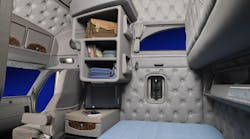The American Trucking Assns. and Minnesota Trucking Assn. have asked the Federal Motor Carrier Safety Administration to conduct a pilot program to study increased flexibility in sleeper berth use by truck drivers. In a Dec. 3 proposal to FMCSA Administrator Anne Ferro, the two groups asked for a two-year exemption from the requirement for 10 consecutive hours of rest for approximately 200 drivers selected for participation in the program.
“The program, if initiated, will help both government and industry translate scientific findings from the laboratory to real-world trucking operations by providing data and information on the relationship between sleeper berth flexibility for off-duty rest and safety outcomes,” said Dave Osiecki, ATA senior vice president, and John Hausladen, MTA president, in a letter to Ferro.
Another objective is to study the role of recent technological advances in monitoring driver alertness and behavior, they said.
Until a rule change in 2005, federal regulations had for decades allowed drivers to split their rest in sleeper berths. FMCSA’s rule change, which followed one of the several court cases involving the HOS rules since 2004, essentially eliminated split rest for solo drivers and allowed team drivers to split rest only in very limited circumstances.
The proposed pilot program would evaluate the safety impacts of allowing split rest in sleepers for both solo and team drivers. Volunteer drivers would be randomly assigned to either a control group of 40 drivers, who would follow current hours-of-service regulations, and 160 drivers operating under the exemption.
ATA and MTA expect a pilot program would take up to two years to complete, including advance preparation. Setting up the program would take about six months and would include identifying study protocols; forming an industry/government oversight committee and intra-company oversight committees to ensure proper monitoring and oversight; integrating data collection and driver monitoring technologies; recruiting participants; and training drivers and dispatchers. Once implemented, the pilot program would run 12 to 18 months.
The data to be collected would be finalized during the preparation phase, but ATA and MTA told FMCSA that the pilot could collect data on:
- Driving behavior that could indicate fatigue, including shifting patterns, speed variability, curve events, and lane departures, as measured by fleet management systems;
- Time to react to stimuli as measured by the Psychomotor Vigilance Task at the beginning and end of work shifts;
- Sleepiness as measured by the 9-point Karolinska Sleepiness Scale collected at the beginning and end of work shifts through either fleet management systems or smartphone apps;
- Crashes and incidents, tracked by time of date, severity and type of crash; and
- Working/resting activity as measured by electronic driver logs for both the control and exemption group, primarily to track how exempt drivers are splitting off-duty time
ATA and MTA also suggested specific protocols for data analysis. One important goal of those protocols would be to isolate the effects of split rest and adjust for differences related to age, experience and average daily mileage.
“Doing a pilot test using professional drivers in actual trucking operations could give the Federal Motor Carrier Safety Administration even more scientific data on which to base future improvements to the sleeper berth rules,” said Bill Graves, ATA president and CEO.
“In the case of many truck drivers, particularly those working in teams, allowing them to break up their 10-hour off-duty period into two shorter periods would be beneficial,” MTA’s Hausladen said.
A similar but less structured effort regarding split rest and other elements of HOS flexibility was proposed unsuccessfully more than seven years ago. Eagan, Minn.-based Dart Transit requested a two-year exemption to allow 200 of its owner-operators to use less rigid off-duty rules subject to implementation of a performance-based fatigue risk management system and use of electronic logs.



